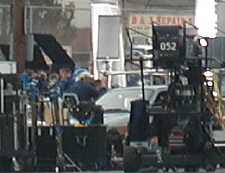For me, watching the crew pack up felt like the end of a circus; that day after the last performance when the acrobats and clowns had taken off their costumes and their makeup to take on grayer garb. They had traded in their magic for the more efficient look of technicians.
The stars had gone onto the next town to work their magic there, leaving this city to the more ordinary folks assigned to pick up the remains, pull up the tent pegs and pack up the platforms and other items they would need somewhere else.
For months, people here had looked ahead in longing to Steven Spielberg’s coming, Bayonne playing its small part in the remake of "War of the Worlds." The film’s star, Tom Cruise, had even wandered around the city, poking his head into the social hot spots, spreading a little cheer while posing for a few photographs.
These things had given the old city some new thrills after years of decline.
Bayonne was the perfect play to film an invasion from outer space, an industrial wasteland that even the huge corporations had abandoned in seeking cheaper labor and reduced taxes elsewhere. Jobs had evaporated in their trail of their leaving, with dust settling over the icons of the city’s former wealth: fuel tanks and pipe works, magnificent empty brick factories.
Citizens here had believed industry would never leave, tracing back the roots of their families and their ties to each company, grandfathers passing jobs onto fathers and father’s onto sons for as long as anyone could remember, leaving the last fathers empty-handed when handing the inheritance to their sons.
Spielberg and Cruise brought their road show to a city struggling to redefine itself. While the two film-makers merely sought out a landscape that would serve as them as a backdrop for an invasion from mars, they carried into the city a flow – if not of hope, then of diversion, a glittering sideshow to which people here could turn their attention for a while, a special moment in time residents could treasure when the ordinary grayness of their lives later returned.
Although scheduled to film here for only six days, the build up took months, evolving first out of rumors of Spielberg’s arrival, then the more physical reality of construction.
Few fairytales had such charm – as when Spielberg knocked on the door of Henry Sanchez and asked to use the Bayonne resident’s home in a movie.
This is the kind of moment most people fantasize about, that discovery on a drug store stool in Hollywood that led to star down, that sudden attention fate gives ordinary mortals that usually remains a figment of hope rather than a reality. Most dream of famous people taking note of us, but most of us live our lives in the gray of quiet desperation, ignored by fate and the famous.
Spielberg’s attentions, however, did not stop there.
Like an army of Johnny Apple Seeds, Spielberg’s minions spread through the neighborhood, striking deals with residents for use of their yards, even paying for the privilege of using the streets outside their houses. This created a sudden social set of lucky souls whose lives were touched by the magic of movies. They became the instant envy of hundreds others who lived outside the filming zone.
As secret as Spielberg was in shaping his dream world – sharing its secrets only with the cabala of residents inside the geographical boundaries of his private vision – some aspects of the massive undertaking could not be hidden from public view and many flocked to these icons if only to stare.
Spielberg constructed a gas station under the arches of the Bayonne bridge, using a local Little League field so that his cameras could have the stunning bridge in their view during filming. The work on the gas station and the reconstruction of yards behind a row of houses served as the many-week build up to the six day show when Spielberg would don his director’s cap and Cruise would exercise his talents as an actor.
When the police finally barricaded off the streets for the shoot and the film equipment rolled into the neighborhood, most people were ready, lining up at the boundary to start out at the bright lights and billows of smoke that rose from the filming location blocks away – each person squinting to make out the distant faces with hopes of catching a glimpse of Spielberg, Cruise or one of the other start engaged in their craft.
For those days, the excitement mounted, partly because Cruise was magnanimous enough to greet the crowds when he was though shooting, giving hand shakes and hugs, sharing words as he posed for pictures with people whose lives craved for one small spark from this fire of immortality. All of it eventually cascaded into one last glimpse of Cruise as he left, the trails of the dream clinging to the wheels of his helicopter as he took off, each fact staring up with the mixture of joy and sadness at the rapidly expiring moment of glory.
In days that followed, the skies grew gray as cleanup crews worked in the rain to pickup the last pieces of the dream and cart them off to some new location where they would be needed to make magic again. A fog hung over Bayonne bridge, taking a long time to dissipate like smoke of an already exploded fireworks whose bright colors have already been committed to memory.
Contact Al Sullivan at asullivan@hudsonreporter.com
